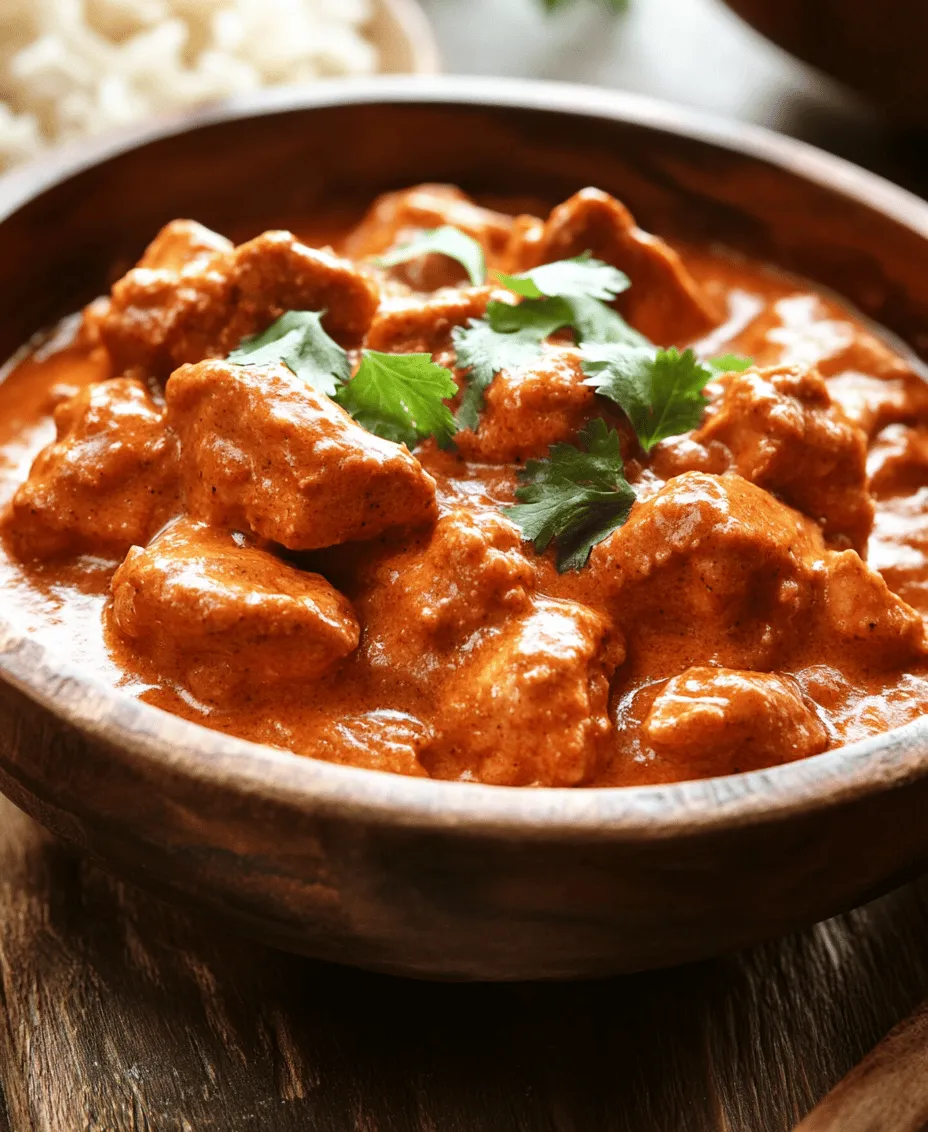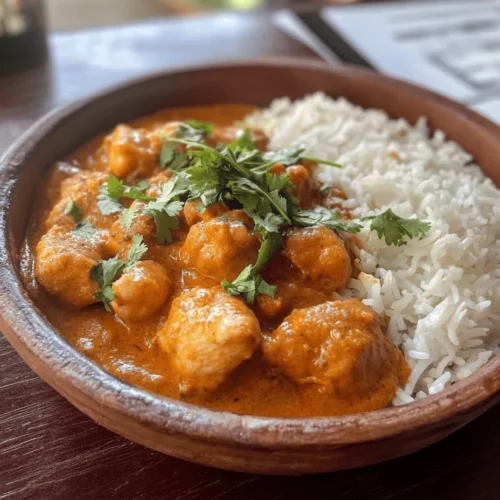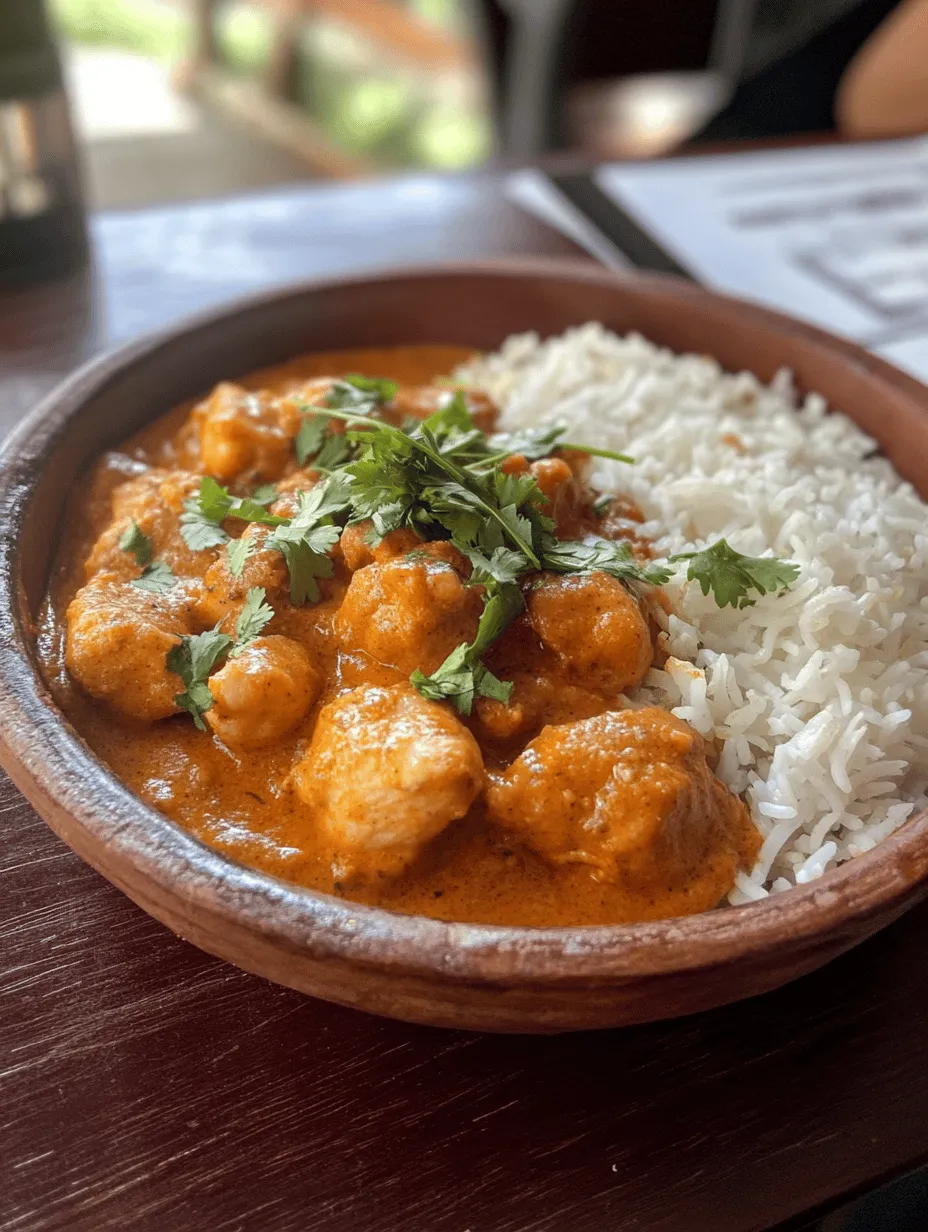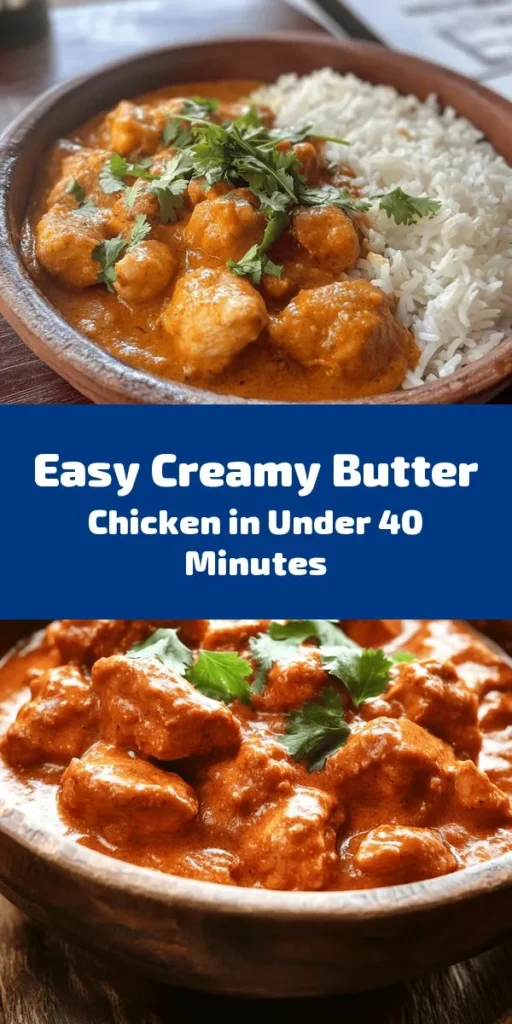Introduction
In the realm of comfort food, few dishes resonate as deeply as Butter Chicken. This iconic Indian dish, known for its rich, creamy sauce and tender chicken pieces, has captivated taste buds around the world. Originating from the vibrant culinary landscape of North India, Butter Chicken, or “Murgh Makhani,” combines the succulent flavors of marinated chicken cooked in a silky tomato-based sauce, enriched with a blend of spices and a touch of cream. With its harmonious balance of flavors, Butter Chicken has not only become a staple in Indian households but has also won hearts globally, making it a favorite on restaurant menus everywhere.
In this post, we will explore a quick and easy recipe for Homemade Butter Chicken that not only retains the authentic flavors but can be prepared in under an hour. Perfect for weeknight dinners or a special occasion, this dish is bound to impress your family and friends. Whether you’re a seasoned cook or a beginner in the kitchen, this recipe simplifies the process without compromising on taste.
The Allure of Butter Chicken
Overview of Butter Chicken’s History
Butter Chicken has an interesting backstory that dates back to the 1950s when the dish was created by the chefs at the Moti Mahal restaurant in Delhi. The original recipe was a clever use of leftover chicken and a mix of sauces that resulted in a rich, buttery gravy. The chefs combined the traditional North Indian cooking techniques with leftover tandoori chicken, resulting in a dish that quickly became a sensation. The creamy tomato sauce, flavored with a blend of spices, ensured that the dish was not only delicious but also comforting, making it an instant favorite among diners.
The Global Popularity of Butter Chicken
Over the decades, Butter Chicken has transcended its Indian roots, gaining immense popularity across the globe. In countries like the United States, Canada, the United Kingdom, and Australia, this dish has been embraced by food lovers who appreciate its comforting flavors and versatility. Restaurants specializing in Indian cuisine often feature Butter Chicken prominently on their menus, catering to both seasoned fans and newcomers eager to explore the world of Indian flavors. The dish’s widespread appeal can be attributed to its rich taste and creamy texture, which can be enjoyed with various accompaniments like naan, rice, or even as a filling for wraps.
Why Homemade is Better: Fresh Ingredients and Control Over Flavors
While you can easily find Butter Chicken in restaurants, nothing compares to the satisfaction of making it at home. Homemade Butter Chicken allows you to control the ingredients, ensuring freshness and quality. You can choose organic chicken, ripe tomatoes, and tailor the spices to suit your palate. Moreover, preparing Butter Chicken at home gives you the freedom to customize the dish according to your preferences, whether that means adjusting the spice levels or adding extra ingredients like vegetables or alternative proteins.
Cooking at home also allows for a more personal touch. You can infuse your family’s culinary traditions or experiment with new flavors, creating a dish that’s uniquely yours. The aroma wafting through your kitchen as the spices blend together is an experience that no restaurant can replicate.
Key Ingredients for Creamy Butter Chicken
Importance of Quality Ingredients
To create a truly memorable Butter Chicken, the quality of your ingredients is paramount. Fresh, high-quality components will enhance the flavor profile of the dish, ensuring that each bite is as delectable as possible. Let’s break down the main ingredients needed for this recipe, highlighting their importance in achieving that creamy, rich texture we all love.
Breakdown of the Main Ingredients
– Chicken Thighs: The Best Choice for Tenderness
While you can use chicken breasts, chicken thighs are highly recommended for Butter Chicken. Thighs are more forgiving when it comes to cooking, providing a juicier, more flavorful experience. They retain moisture better than breasts, ensuring that the chicken remains tender throughout the cooking process.
– Spices: The Heart of Indian Cuisine
A well-crafted Butter Chicken relies heavily on spices. Commonly used spices in this recipe include garam masala, cumin, coriander, turmeric, and chili powder. These spices not only provide warmth and depth but also contribute to the dish’s signature flavor. Using whole spices, when possible, can elevate the dish even further, as they release more aromatic oils.
– Tomato Puree: Achieving the Perfect Base
The base of Butter Chicken is a rich tomato puree that adds acidity and sweetness. It’s essential to use a good quality tomato puree or crushed tomatoes to create a smooth, rich sauce. You can also opt for fresh tomatoes, but using a puree saves time and simplifies the cooking process.
– Heavy Cream: The Secret to Creaminess
To achieve the signature creaminess of Butter Chicken, heavy cream is added to the sauce. This ingredient not only enriches the dish but also balances the spices, creating a luscious texture that coats the chicken beautifully. For a lighter option, you can substitute with coconut cream, though it will impart a different flavor.
Optional Ingredients for Customization
Homemade Butter Chicken is versatile and can be customized based on personal preferences. Below are a few options to consider:
– Adding Vegetables: Peas, Spinach, or Bell Peppers
For a nutritional boost, consider adding vegetables to your Butter Chicken. Green peas or spinach can easily be incorporated into the sauce, providing both color and added flavor. Bell peppers can also be sautéed and added for a crunchy texture.
– Alternative Proteins: Paneer or Tofu for Vegetarian Options
If you’re looking for a vegetarian alternative, paneer (Indian cottage cheese) or tofu are great substitutes for chicken. Simply marinate and cook them in the same way as the chicken, allowing them to soak up all those delicious flavors.
Step-by-Step Guide to Making Butter Chicken
Marination: The Foundation of Flavor
The first and most crucial step in making Butter Chicken is marinating the chicken. Marination not only infuses the meat with flavor but also tenderizes it, ensuring a juicy final product.
Importance of Marinating Chicken
Marination is a technique that allows the spices and yogurt to penetrate the chicken, enhancing its taste and texture. A good marinade typically includes yogurt, spices, and sometimes lemon juice, which helps to break down the chicken fibers, making it more tender.
Suggested Marination Time and Techniques
For optimal flavor, marinate the chicken thighs for at least 30 minutes, though a longer marination time of up to 4 hours or overnight in the refrigerator can yield even better results. To marinate, simply combine yogurt, your chosen spices, and the chicken in a bowl, ensuring the chicken is well-coated. Cover it with plastic wrap and refrigerate until you’re ready to cook.
Sautéing: Building the Flavor Profile
Once your chicken is marinated, the next step is to sauté the ingredients that will form the base of your Butter Chicken sauce.
Tips for Perfectly Sautéed Onions
Start by heating oil or ghee (clarified butter) in a large pan over medium heat. Once hot, add finely chopped onions and sauté until they turn golden brown. This process is crucial, as caramelized onions add a sweet depth to the sauce. Stir often to prevent burning, and be patient; this step usually takes around 8-10 minutes.
After the onions are caramelized, add ginger and garlic paste, followed by the spices. Cook for an additional minute to allow the spices to bloom and release their essential oils. This step is vital for building the flavor profile of your Butter Chicken.
As you progress through these initial steps, you’re already setting the stage for an unforgettable culinary experience. The combination of marinated chicken, sautéed onions, and aromatic spices will create a tantalizing aroma in your kitchen that will leave everyone eager for what’s to come.
In the next part of this article, we will delve deeper into the remaining cooking steps, including how to combine all ingredients into a silky, creamy sauce and perfect the dish for serving. Stay tuned for that delicious journey ahead!

The Role of Garlic and Ginger in Enhancing the Dish
Garlic and ginger are not just mere ingredients; they are fundamental to elevating the flavor profile of butter chicken. Garlic adds a pungent, savory depth that balances the creaminess of the sauce, while ginger introduces a warm, zesty kick that brightens the dish. Together, they create a harmonious blend that enhances the overall taste experience. When using fresh garlic and ginger, the aromatic qualities become even more pronounced, infusing the chicken and sauce with an irresistible fragrance. To maximize their impact, be sure to finely mince the garlic and ginger before adding them to your cooking process, ensuring that their flavors meld beautifully with the other ingredients.
Cooking the Chicken: Achieving the Right Texture
The key to a successful butter chicken lies in how the chicken is cooked. Begin by marinating your chicken pieces in yogurt and spices, allowing them to absorb flavor and tenderize. This marination process not only infuses the meat with taste but also helps keep it juicy during cooking.
When it comes time to cook the chicken, consider using a combination of sautéing and simmering. Start by searing the marinated chicken in a hot pan with oil or ghee until it develops a golden-brown crust. This step is crucial as it adds depth of flavor through the Maillard reaction. Once seared, reduce the heat and allow the chicken to simmer gently in the sauce. This two-step process helps achieve a tender, juicy texture that is the hallmark of great butter chicken.
Signs of Properly Cooked Chicken
To ensure that your chicken is cooked to perfection, look for several signs. First, the chicken should be opaque and no longer pink in the center. A meat thermometer can also be a handy tool; chicken should reach an internal temperature of 165°F (75°C). Additionally, when you cut into a piece, the juices should run clear, not pinkish. Following these signs will guarantee that your butter chicken is both safe to eat and deliciously tender.
How to Prevent Dryness
One of the common pitfalls when cooking chicken is ending up with dry meat. To avoid this, there are several techniques you can employ. First, avoid overcooking the chicken; it’s better to undercook slightly as it will continue to cook in the residual heat of the sauce. Second, keep your cooking temperature moderate; high heat can lead to quick cooking on the outside while leaving the inside undercooked. Lastly, always let the chicken rest for a few minutes after cooking. This resting period allows the juices to redistribute throughout the meat, contributing to a moist final product.
Creating the Sauce: The Creamy Transformation
The sauce is the soul of butter chicken, and creating it requires a careful balance of ingredients. Start by sautéing onions until they are golden brown, which adds sweetness and depth to the sauce. Next, incorporate the garlic and ginger, allowing them to sauté just until fragrant.
Once you’ve built this base, add the tomatoes. Using canned tomatoes or fresh tomatoes that have been blended will provide the necessary acidity and body to the sauce. After the tomatoes have cooked down, it’s time to introduce the cream, which is essential for that signature richness. The cream should be added gradually, allowing it to blend smoothly with the other ingredients.
Techniques for a Smooth Sauce
A smooth, velvety sauce is a hallmark of well-made butter chicken. To achieve this, consider using a blender or an immersion blender to puree the sauce once it has cooked down. This step will eliminate any chunks and create a creamy consistency. If you prefer a chunkier sauce, be sure to finely chop the onions and tomatoes to minimize texture discrepancies. Additionally, straining the sauce through a fine mesh sieve can help eliminate any remaining solids and give you that desired silky finish.
Adjusting Spices to Your Taste
Butter chicken is highly customizable, particularly when it comes to spices. The traditional recipe typically includes garam masala, cumin, and coriander, but feel free to adjust the quantities to suit your palate. If you enjoy heat, consider adding cayenne pepper or red chili powder to amp up the spice level. Conversely, if you prefer a milder flavor, reduce the amount of spices or choose sweeter spices like cinnamon or cardamom. Always taste the sauce as you go, making adjustments to ensure it meets your flavor preferences.
Final Touches: Garnishing and Serving Suggestions
Once your butter chicken is complete, the final touches can elevate the dish even further. Fresh cilantro is a must; it not only adds a vibrant green color but also a fresh, herbaceous flavor that brightens the rich sauce. Simply chop some cilantro and sprinkle it over the top just before serving.
For presentation, serve your butter chicken in a shallow bowl, drizzling some additional cream over the top for a restaurant-quality look. Accompany the dish with fluffy basmati rice or warm naan bread, perfect for soaking up every last bit of sauce.
Importance of Fresh Cilantro
Fresh cilantro is more than just a garnish; it plays a crucial role in balancing the rich flavors of butter chicken. The bright, citrusy notes of cilantro cut through the creaminess, providing a refreshing contrast. Moreover, cilantro is packed with antioxidants and has potential health benefits, including anti-inflammatory properties. Always opt for fresh cilantro rather than dried, as the latter lacks the vibrant flavor and aroma that fresh herbs deliver.
Presentation Ideas for Serving
Presentation can make a significant difference in how a dish is perceived and enjoyed. When serving butter chicken, consider using colorful dishes to enhance the visual appeal. For instance, a white bowl can help the vibrant orange-red sauce pop. Garnishing with a sprinkle of cilantro and a drizzle of cream adds a gourmet touch. Pair your dish with sides like fluffy basmati rice or warm naan, arranged attractively on the plate to create a visually appealing meal.
Nutritional Benefits of Homemade Butter Chicken
Balanced Nutrition in a Comfort Dish
Homemade butter chicken can be a balanced meal, providing a good source of protein from the chicken, healthy fats from the cream, and vitamins from the spices and tomatoes. When made with whole, fresh ingredients, it can fit well into a healthy diet. Additionally, the inclusion of spices like turmeric and cumin not only enhances flavor but also contributes anti-inflammatory benefits.
Healthier Alternatives: Lowering Calories and Fat
For those looking to make butter chicken a bit lighter, there are several alternatives. You can substitute heavy cream with Greek yogurt for a tangy flavor and lower fat content while still achieving a creamy texture. Using chicken breast instead of thighs will also reduce the overall fat. Moreover, consider using less oil during cooking and incorporating more vegetables, like bell peppers or spinach, to increase the nutritional value without sacrificing flavor.
The Role of Spices in Health Benefits
Many spices used in butter chicken, such as turmeric, cumin, and coriander, offer numerous health benefits. Turmeric, for instance, is known for its anti-inflammatory properties, while cumin aids in digestion. Coriander has been linked to lowering blood sugar levels and improving cholesterol. By incorporating these spices, not only do you enhance the dish’s flavor, but you also contribute to your overall health.
Pairing Suggestions for Butter Chicken
Best Sides to Complement Butter Chicken
To create a well-rounded meal, consider pairing butter chicken with classic accompaniments. Basmati rice is a traditional choice, known for its fragrant aroma and fluffy texture, making it perfect for soaking up the rich sauce.
Basmati Rice: The Traditional Choice
Basmati rice is not only a staple in Indian cuisine but also complements butter chicken beautifully. Its long grains and light, fluffy texture provide a neutral base that balances the rich flavors of the dish. To prepare basmati rice, rinse it under cold water until the water runs clear, then soak for 30 minutes before cooking to achieve the perfect texture.
Naan Bread: Perfect for Scooping
Naan bread is another essential component when serving butter chicken. Its soft, pillowy texture offers a delightful contrast to the creamy sauce, making it ideal for scooping up bites. You can purchase store-bought naan or make your own for an authentic touch. To elevate the experience, brush the naan with garlic butter before serving for added flavor.
Beverage Pairings: What to Drink with Butter Chicken
Choosing the right beverage can enhance your butter chicken experience. For alcoholic options, consider a light, crisp white wine like Sauvignon Blanc or a fruity red such as Pinot Noir, both of which complement the dish’s flavors without overpowering them.
Wine Pairings: Red or White?
When it comes to wine, both red and white can work with butter chicken, depending on your preference. A medium-bodied red with soft tannins can complement the dish, while a chilled white can provide a refreshing contrast to the rich sauce. If you prefer beer, a light lager or pale ale can also be a great pairing.
Non-Alcoholic Options: Lassi and More
For a non-alcoholic option, a traditional mango lassi is a fantastic choice. This yogurt-based drink is refreshing and helps balance the spices in the dish. Alternatively, a simple lemonade or iced tea can also provide a delightful contrast to the richness of the butter chicken.
Conclusion
Homemade butter chicken is not only a delightful dish that you can whip up in a short amount of time, but it also embodies the essence of comfort food. With its rich flavors and creamy texture, it’s easy to see why it has become a favorite around the world. By following this step-by-step guide, you can create a restaurant-quality meal right in your own kitchen, making it a perfect addition to your recipe repertoire. Enjoy the process and savor the results of your culinary efforts!



